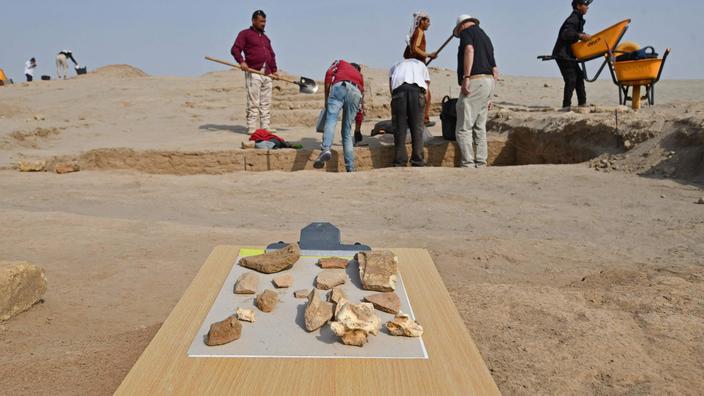"Come to see!"
French archaeologists are jubilant.
They have just unearthed a 4,000-year-old cuneiform inscription in the Iraqi desert which, due to the conflicts that tore Iraq apart, has not seen foreign archaeologists for decades.
"When we find inscriptions like that, in situ, it's moving
," enthuses Dominique Charpin, holder of the chair of Mesopotamian Civilization at the College de France, also traveling for this excavation campaign carried out at the end of 2021 in Larsa. , in southern Iraq.
The inscription in the Sumerian language was carved on a fired brick in the 19th century BC.
"To the god Shamash, his king Sîn-iddinam, king of Larsa, king of Sumer and Akkad"
, translates Dominique Charpin with disconcerting ease.
Behind him are active a dozen French, European and Iraqi archaeologists in an excavation area delimited by cords.
Some brush bricks, others remove dirt, all cleared away what looks like the pile of a bridge that spanned the urban canal of Larsa, the capital of Mesopotamia just before Babylon, at the start of the second millennium BCE.
"Larsa is one of the largest sites in Iraq, it covers more than 200 hectares"
, comments Régis Vallet, researcher at the National Center for Scientific Research (CNRS), who heads the Franco-Iraqi mission, with a strong twenty people.
The campaign led to
“major discoveries”
, including that of the residence of a head of government at the time, identified by around sixty cuneiform tablets then transferred to the National Museum in Baghdad.
Paradise for archaeologists
Larsa is a formidable playground, a
"paradise"
, suggests Régis Vallet, just like all of Iraq, ancient Mesopotamia which saw the successive empire of Akkad, the Babylonians, Alexander the Great, the Christians, the Persians and Islam.
But it was Iraq's immediate history and its share of conflicts that kept long-time scholars from abroad at bay.
There was first the First Gulf War in 1990-1991, then the embargo, followed by the invasion led by the United States in 2003, the interfaith conflict of the years 2006-2009, and finally the offensive by the jihadists of the Islamic State (IS) group who occupied up to a third of Iraqi territory in 2014.
Régis Vallet, researcher at the National Center for Scientific Research (CNRS), heads the Franco-Iraqi mission.
ASAAD NIAZI / AFP
Since the Iraqi state claimed its
“victory”
over IS in 2017, the country
“has largely stabilized and it has become possible again”
to go to Iraq, explains Régis Vallet.
“The French came back in 2019 and the English a little earlier. The Italians came back in 2011, ”
he says. At the end of 2021, there were, according to him, ten foreign archaeological missions in the governorate of Dhi Qar, where Larsa is located.
Director of the Iraqi Council of Antiquities and Heritage, Laith Majid Hussein is more than enthusiastic about the idea of welcoming foreign colleagues.
"This is scientifically beneficial to us and it is an opportunity for the training of our staff after this long hiatus
," he said in an interview with AFP in Baghdad.
"Cradle of civilizations"
Near Najaf, a Shiite holy city in central Iraq, Ibrahim Salman of the German Institute of Archeology is also very happy to have found the ground for a prospecting campaign on the site of the ancient city of Al-Hira.
Because from 2003 to 2013, German archaeologists were not able to access the Iraqi excavation sites either.
Equipped with a geomagnetic measuring device, Ibrahim Salman's team probes the bowels of the tells where Al-Hira was located, a long-Christian city that reached its peak during the Lakhmids era, in the 5th and 6th centuries.
"We are on a tell that we are going to search.
There are indications that a church could have been there
, ”explains the scientist.
These
“clues”
consist of traces left on the ground by moisture retained by structures buried underground and which gradually rises to the surface.
The earth moistened on a strip several meters long leads to the conclusion that under the archaeologist's feet are undoubtedly the partitions of the old church.
And if the Al-Hira site is much more recent than other archaeological sites, their diversity clearly shows, according to Ibrahim Salman, that
“Iraq, or Mesopotamia, is the cradle of civilizations.
It’s that simple ”
.

